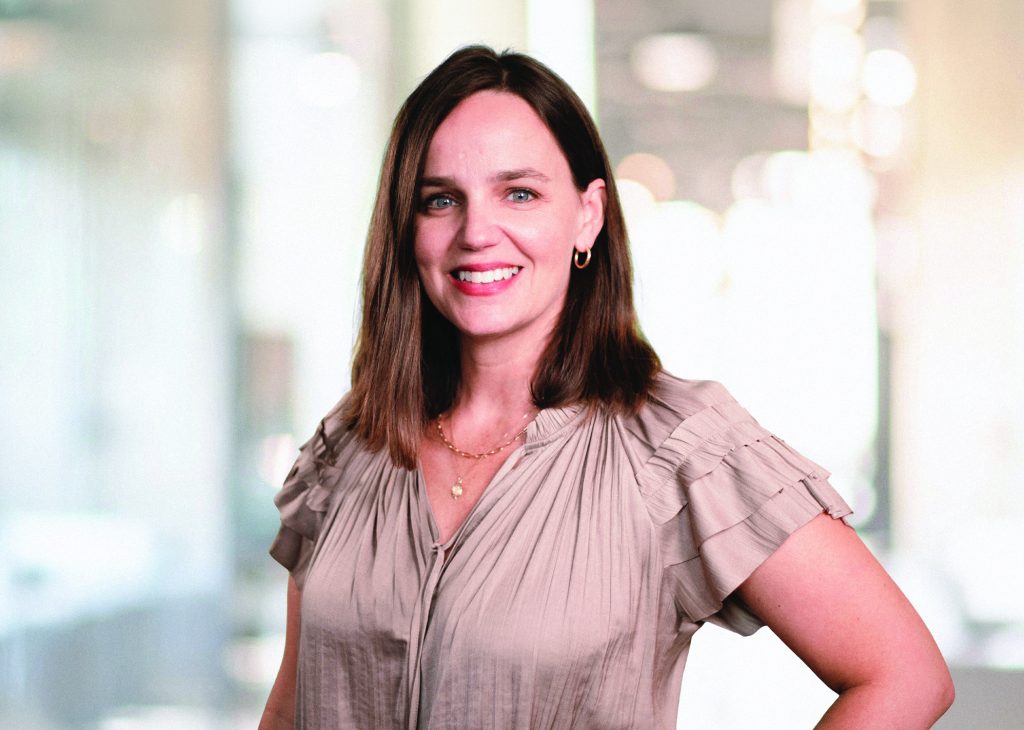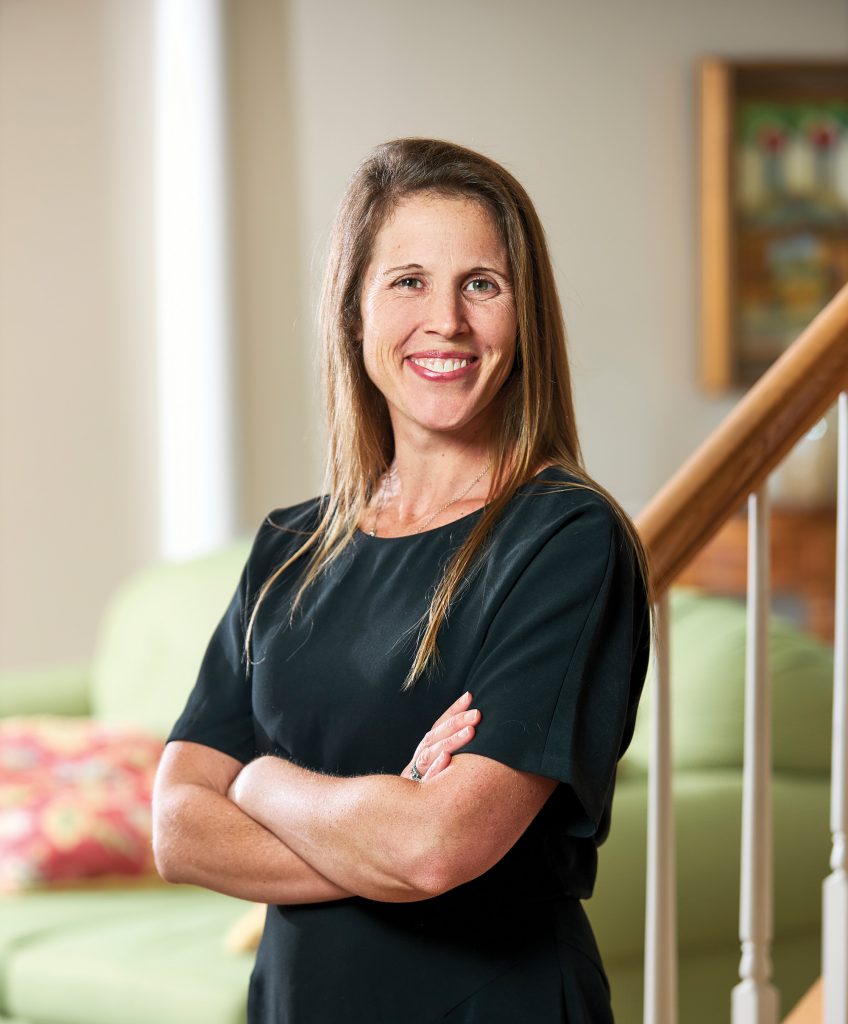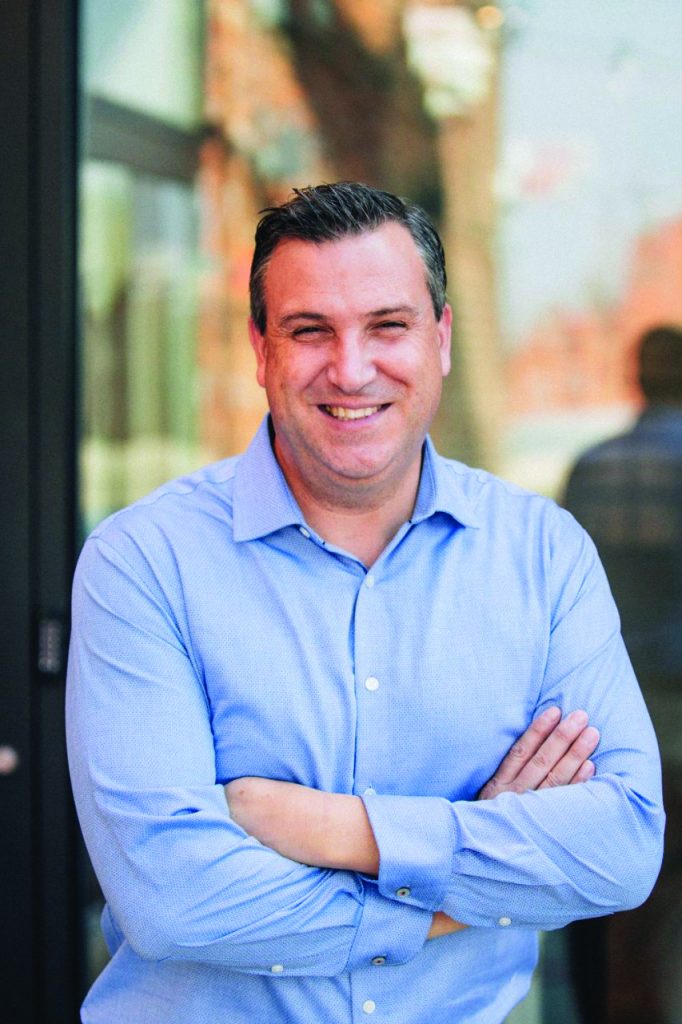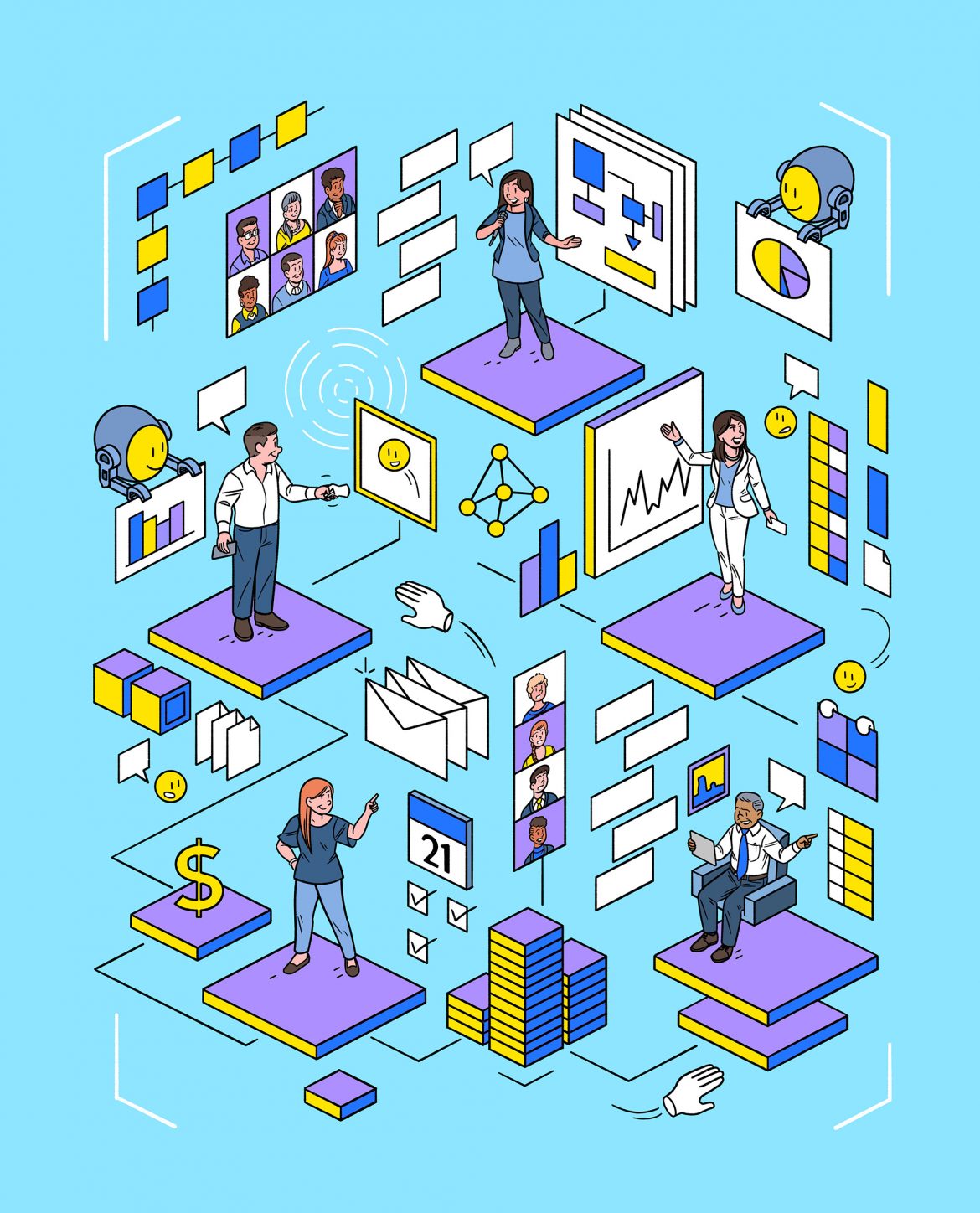We’re living in a world today where anyone can ask ChatGPT anything. Virtual assistants answer emails and sit in meetings as a proxy for their humans. Robots complete manual tasks that only humans could do before. Organizations develop machine-learning algorithms to predict future trends, such as pricing.
Artificial intelligence is here, and it’s expanding throughout our consciousness and our lives with great speed. Realm sits down with five leading AI experts in the region to collect their insights on and advice about this new horizon of technology and how it will impact the workplace and business in general.
[Illustration by Janne Iivonen]

KENDRA RAMIREZ, CEO OF KR DIGITAL AGENCY
Kendra Ramirez has a favorite T-shirt that reads: HI>AI. “Human intelligence is greater than artificial intelligence,” she says, adding that it’s been a guiding principle at her consulting agency as well as at Cincinnati AI for Humans, a networking group she co-founded with Helen Todd in 2023 that’s grown to more than 1,400 members.
Ramirez is known for making AI approachable. “I apply everything to how an organization or business is operating and working today,” she says. “I see it very much from the human element.”
For the last 20 years, her agency has worked to keep clients ahead of the digital curve, mainly on websites in the early years. Ramirez has offered AI services since 2018, likening the advent of artificial intelligence to the introduction of the car during the heyday of horses and buggies. Both advancements can amplify what human beings capable of, if they learn how to drive.
“In every technology shift, it’s women, minorities, small businesses, and nonprofits that get left behind,” Ramirez says. “I feel passionately that AI democratizes society, because anyone can use it. I don’t want anyone left behind.”
Her agency provides a suite of AI services from education, readiness, and strategy to implementation, policy creation, and training. She also advises clients on how to create an AI Task Force or AI Council to keep up with AI’s constant advancements. “We’re often brought in with the question Where do we start? or What else should we be considering?” says Ramirez, who has tested more than 100 AI tools at this point.
She’s seen some impressive results. One team saved 1,400-man-hours by applying two AI tools. The first was a transcription tool to automate and summarize meeting notes, recaps, and next steps, while the second streamlined the company’s documentation review process. She found a tool for another one of her clients that cut down podcast editing from an average of seven hours to 40 minutes.
“Do we feel lazy or guilty using a formula in an Excel spreadsheet? No, we don’t,” Ramirez says. “Right now, AI is a competitive edge, but it’s not always going to be that way. The generation being born right now isn’t going to talk about AI—they’re just going to talk about work.”
Ramirez encourages those with a piqued interest to attend a monthly Cincy AI for Humans meeting at the University of Cincinnati’s Digital Futures building. Find their meeting schedule at cincyai.org.
SANDY STEIGER, DIRECTOR OF DATA AND DEVELOPMENT AT LITHKO CONTRACTING

If you’re a business or nonprofit leader and want to start exploring the use of artificial intelligence in your company or nonprofit, Sandy Steiger’s advice is to first identify the problem you want to solve. Is there a tedious task your staff is always complaining about? Where is time being wasted or opportunity lost?
“If your mission is to use artificial intelligence so that you can say your company is doing artificial intelli gence, then you’re coming at this all wrong,” says Steiger of Lithko Contracting. “The companies that will be most successful are the ones with a vision and a strategy and know what problems they need solved. Then you can ask, How does AI plug in?”
A self-described numbers girl at heart, Steiger earned a master’s degree in statistics and worked as a data analyst at dunnhumby and a data scientist at 84.51 before teaching business analytics at Miami University for six years. She left academics three years ago to take a senior position at Total Quality Logistics, and she joined Lithko in May.
TQL was an early adopter of AI, and today it uses AI tools to forecast markets, predict pricing, consolidate loads, and find the best freight carrier. The brokerage firm has 40 bots in operation to automate manual and repetitive tasks that before took the time of 90 people, Steiger says.
Before any organization, big or small, launches its own AI journey, leaders must understand their own data and make sure it’s accurate and complete before going any further, Steiger says. Once you’ve determined you’re at a good staring place, she suggests thinking big and starting small, sharing an example from the U.S. Postal Service.
“Their customer service agents are inundated and are getting too many calls,” Steiger says. “But they started small. They said, What’s the number one thing to solve for? What do we get a question about most often? It turns out to be, Where’s my package?” So USPS created an AI tool to automate package tracking on its website and on the phone, freeing up customer service people to answer other questions.
Steiger suggests using ChatGPT to brainstorm ideas, too, but offers a warning. It does require a new way of thinking, perhaps even a different level of critical thinking. “AI is going to answer almost every single question you ask it, but it might not be the right answer,” Steiger says. “You have to ask yourself, How do I research that to make sure it’s real?”
Part of Steiger’s role at TQL was to serve as a bridge between the technical folks and everyone else in the business, and she says it’s important to have everyone in the room as you work on finding solutions in order to get buy-in. She also cautions business leaders to monitor their AI tools because—while they’re getting better at what they do all the time—they can produce factually inaccurate or illogical answers due to data and architectural constraints.
“If you’re thinking about machine-learning algorithms in the predictive and prescriptive space, you’ve got to be looking for drift,” Steiger says. “Maybe that’s because new data has been coming in or there’s been a shift in the market that makes the model perform less ideally than we would like.”
MADDIE BELL, CO-FOUNDER AND CEO OF SYNAPSA

Two things are inevitably true, Maddie Bell says: Humans will always have meetings, and the way humans orchestrate those meetings will continue to change based on the technology and tools available. She’d like to introduce you—particularly if you lead a business that sells something—to Synapsa, an AI solution for meetings that she and her co-founder and husband Mike Bell have developed for the sales industry.
“Businesses need to engage buyers the instant they raise their hand,” Bell says. “It isn’t enough to do it in days. It’s not even enough to do it in under five minutes. You need to engage them the instant they say, Hey, I think I’m interested. You immediately need to understand whether they’re a good fit for your business.”
It turns out that AI can be good at this task, Bell says. While scheduling a meeting might seem like a moment in time, there’s actually a whole set of conversations that must happen as well as context added, Bell says, before you can get to a potential sale. Not to mention that 40 percent of meetings are rescheduled, changed, or double-booked, she says. If the buyer doesn’t end up qualifying? More waste of time.
Synapsa develops artificially intelligent systems that have those conversations with potential buyers and then convert the conversations into meetings, ultimately creating a path to new business growth. “AI that serves people and actually creates more of the right human-to-human connections,” says Bell, “because now you’ve matched the buyer’s intent with the right next step.”
Bell left her position as a brand director at Procter & Gamble two years ago to join her husband, who left his position as vice president of data engineering and machine learning at Nielsen, to create Synapsa. Their AI tools engage with potential buyers via a company’s website, by email, or by text.
For example, Synapsa developed a webchat for one client to engage with 500 of the 200,000 visitors who came to their site. Thirty-three ended up being qualified buyers, but the connections achieved with AI brought in multiple six-figure deals. “You’re never going to pay a human to do that,” Bell says. “But of those 33 qualified leads, 25 meetings got booked. That’s a 78 percent book rate, which is massive.”
Synapsa built a tool for another client that sent out 200 texts, booked 41 qualified leads, and cleared multiple deals. “We always tell people micro moments do have a macro impact at scale,” says Bell. “These conversations on the website, these content downloads, these making sure people are going to show up to the call, the result is that macro output.”
Synapsa is continuing to transform as AI develops and its uses expand, Bell says. “What you were building yesterday isn’t what you’re building tomorrow, because the landscape is moving so quickly.”
PETE BLACKSHAW, CO-FOUNDER AND CEO OF BRANDRANK.AI

When ChatGPT was publicly released on November 30, 2022, Pete Blackshaw was on vacation with his family. As they slept, the former digital marketing executive for Procter & Gamble and Nestlé found himself obsessively plugging in questions: Is such-in-such brand sustainable? What do consumers feel about this product or another?
“I was kind of blown away at how uncomfortably honest AI is about brands,” Blackshaw says. “ChatGPT is like the gift of simplicity, and now you can do it with voice. I was thinking, Someone’s got to create a meter to help brands understand what’s being said about them.”
And so he did, leaving his job as chief operation officer at Cintrifuse, the “fund of funds” startup incubator that transformed into a local venture capital group a couple of years ago, to build Brandrank.ai with co-founder Hank Hudepohl, a former executive at TripAdvisor and Paycor.
ChatGPT is just one of a growing number of AI-driven search and discovery tools, Blackshaw says. There’s also Gemini, Perplexity, DeepSeek, Grok, and Anthropic. Brandrank.ai conducts an audit of them all, based on three metrics: visibility (does the brand show up in AI-driven searches), vulnerability (what are they saying), and readiness (how to operate in order to protect your brand). “You really need to understand how the algorithms harvest data,” he says. “Your brand is a smoothie in the world of Generative AI, but you need to make your ingredients accessible. Brands need to think differently about how they get their story out there.”
He sees Brandrank.ai as a platform for brand health and trust in the fast-growing “Answer Engine” measurement space, and it’s getting noticed. In March, Brandrank.ai beat 500 other start-ups to win HumanX, a competition for AI-first companies backed by Google Cloud, and Blackshaw made the inaugural “AI Trailblazers Power 100” list in April chosen by Adweek magazine and the invite-only industry group AI Trailblazers.
Being AI-first means Brandrank.ai is using AI for just about everything, Blackshaw says, including 90 percent of its coding. His team even made him a bot that’s continuously learning how he speaks and thinks. “A bot that can write articles like Pete,” he says. “Even in our delivery with clients, there’s artificially generated Pete sitting on his little pedestal giving advice, sometimes in Spanish, sometimes in English.”
Blackshaw says there are a lot of complicated questions still to be managed around disclosure, meaning that people need to know if and when they’re talking to human Pete and when they’re talking to the bot. “But I do think it opens up a lot of possibilities. I mean, people like the energy of people, and some of that can be automated.”
Blackshaw calls AI “the world’s greatest gift to entrepreneurs,” because it makes work more efficient and less expensive. He launched Brandrank.ai with $1.2 million in seed funding—just a fraction of the $31 million it took him to launch an earlier start-up, Planet Feedback, which was eventually sold to Nielsen.
“AI is the great equalizer,” he says. “The public tool has been available for less than three years. Things are happening at warp speed. Companies, particularly big ones, need to have their eyes really, really wide open and be a little bit paranoid.”

JORGE PEREZ, PRESIDENT AND CEO OF YMCA OF GREATER CINCINNATI
Every Monday, an AI agent that Jorge Perez built sends him an email. “The agent has been trained to look at my personality profile and the YMCA’s strategic plan and share with me a principle to help me be a better CEO,” he says. If you think that’s impressive, hold onto your hat.
At 60, Perez often finds himself the oldest person in a room of AI adopters, but since he was a kid who saved his money to buy the first Commodore 64 he’s been enthusiastic about technology’s advancement. He says he began to recognize AI’s “extraordinary capacity to help individuals do their work” when he began using ChatGPT. As the head of the YMCA of Greater Cincinnati, he oversees 13 membership locations serving about 140,000 individuals a year, as well as 70-plus before- and after-school child care sites and four early learning centers in a five-county region.
“We’re not using AI to find a way to replace people but really to empower them and supercharge their ability to do our mission to help people achieve, relate, and belong,” says Perez. “Now we’ve got this new set of tools, this new team that has come alongside us, helping us do it faster and better.”
The “team” of which Perez speaks is made up of 16 AI agents developed inside ChatGPT. There’s Yasmine, an AI agent for youth development. Finley takes questions about fundraising, and Izzy is the IT advisor. Marlow can help with membership questions, and Harmony is an expert at human resources. “This stuff is so amazingly user-friendly,” Perez says. “We designed one in about 45 minutes and then we said, Let’s design 15 more. It’s just like creating a job description—you want them to have five years of experience, be able to do X, and have a degree in marketing, for example, with Morgan.”
In developing the agents, the YMCA added organizational background, values, protocols, and all of the material it would need. It’s like hiring a college graduate who’s been through orientation and remembers everything, Perez says.
Created and monitored in Cincinnati, the agents have been rolled out to the entire YMCA system throughout the U.S. and Canada. Each answers questions 24/7 and can take 150,000 questions at a time, Perez says. And the more that staff members use them, the more the agents learn and improve. “When you’re in the business of trying to serve everyone and you have a limited staff to do it, the idea of all of a sudden having more support is just exciting,” says Perez. “That means we can do far more than we can do right now.”
The agents have their limitations, he says, and he teaches his staff to be on the lookout for the moment when a consumer situation needs human-to-human engagement.
The Y is headed into Phase 2 of its AI integration, Perez says, looking at creating agents for every employee and how AI tools could work with its other systems. They’re discussing connecting the cameras at the physical Y locations to an AI agent, which is asked to watch for and alert them if a senior falls, a child is crying, a fight breaks out, a car gets broken into, or an adult who visits frequently is having difficulty making friends.
“It could become an extension to the strategy that you’re trying to reach,” he says. “I believe we have an opportunity to scale what for many of us has been impossible. It can be used for good, and that’s what I’m interested in.”


